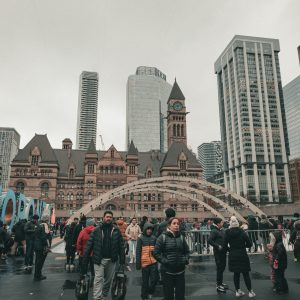‘Slow disaster’: Indonesians in sinking village forced to adapt
Timbulsloko, Indonesia (AFP):
Indonesian teacher Sulkan leafs through pictures at his small sea-surrounded mosque, remembering a marching band and smiling children who graduated from his kindergarten, standing on a road now submerged by murky, green water.
That is just one of many landmarks in the Javan coastal village of Timbulsloko swallowed by rising tides, which have forced residents to adapt to a new life on the water.
More than 200 people have stayed in one of Indonesia’s fastest sinking areas, which has turned from a landscape of lush rice paddies into a network of boardwalks and canoes in an alarming sign of how climate change could upend coastal communities everywhere.
“It’s only memories now… there are no such activities any more,” said 49-year-old Sulkan, who like many Indonesians goes by one name.
“Why? Because the place is already flooded by the tide.”
Timbulsloko residents’ lives have been drastically altered by rising sea levels, coastal erosion and excessive groundwater extraction making the land sink.
The coastline has also been left vulnerable to floods after locals cut down mangroves for fishing ponds in the 1990s.
Water has since reached five kilometres inland around Timbulsloko and the surrounding Demak region, according to Denny Nugroho Sugianto, professor at Diponegoro University.
He called it a “slow disaster” happening before the world’s eyes, with data showing some areas around Timbulsloko sinking up to 20 centimetres annually, double the rate recorded in 2010.
“This is the largest rate of land subsidence” ever recorded in the area, he said.
‘No future’
Large parts of megalopolis capital Jakarta are expected to be submerged by 2050 for the same reasons, researchers say, but villagers along the Javan coast are on the front lines of the emergency.
Sulkan was forced to move his kindergarten from an old wooden building next to his house to another structure on higher land to prevent it from being lost.
Residents have elevated the floors of their homes by adding soil and then installing wooden decks to keep themselves dry as the floods become more severe.
This has left them with shrinking space, forcing anyone entering to stoop low to avoid bumping their heads.
Sularso, 54, said he had raised his floor three times since 2018, by a total of 1.5 metres, spending around 22 million rupiah ($1,460).
“For me, there is no future,” the fisherman said.
“This village… will be gone in less than five years. We can’t build, we can’t do anything.”
He says his floor can still be submerged in water during high tides, leaving him worried high waves could collapse his home.
Housewife Khoiriyah, 42, said she has had difficulty buying groceries or taking her three children to school because of flooded roads.
“Life is harder now. Whenever the water comes inside my house, I always wish I could move out,” she said.
Yet the problem is due to become even worse as climate change grinds on.
The UN’s Intergovernmental Panel on Climate Change (IPCC) says an increase of two degrees Celsius from pre-industrial times could raise sea levels by 43 centimetres by the next century.










